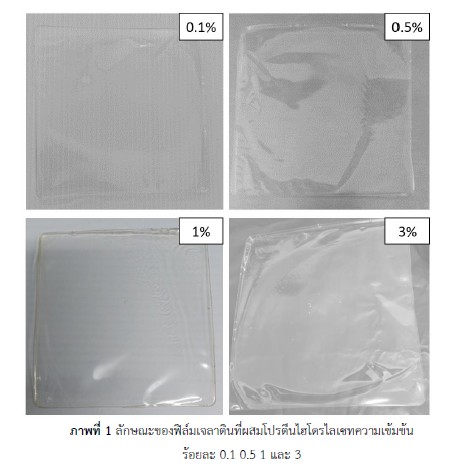ผลของการเติมโปรตีนไฮโดรไลเซทต่อคุณสมบัติของเจลาตินฟิล์ม และความสามารถในการป้องกันการเกิดปฏิกิริยาสีน้ำตาลบนผิวของผลไม้
Main Article Content
บทคัดย่อ
งานวิจัยนี้มีวัตถุประสงค์เพื่อศึกษาผลของโปรตีนไฮโดรไลเซทต่อคุณสมบัติของฟิล์มเจลาติน ซึ่งโปรตีนไฮโดรไลเซทผลิตโดยการย่อยกากถั่วเหลืองด้วยเอนไซม์โบรมิเลน ศึกษาเปรียบเทียบคุณสมบัติของฟิล์มที่ผสมโปรตีนไฮโดรไลเซทความเข้มข้นร้อยละ 0.1 0.5 1 และ 3 ทางด้านกายภาพและด้านการป้องกันการเกิดปฏิกิริยาสีน้ำตาล ผลการศึกษาพบว่าคุณสมบัติของฟิล์มทุกด้านมีแนวโน้มเพิ่มขึ้นแปรผันตามปริมาณโปรตีนไฮโดรไลเซทที่เติมลงไป ฟิล์มที่ผสมโปรตีนไฮโดรไลเซทร้อยละ 3 มีคุณสมบัติด้านการต้านทานการดึง และการซึมผ่านไอน้ำดีที่สุด โดยมีค่าเท่ากับ 39.50 MPa และ 1.15 g mm/kPa h−1 m−2 ตามลำดับ ฟิล์มที่ผสมโปรตีนไฮโดรไลเซทมีความหนามากขึ้น และมีเฉดสีเหลืองเข้มขึ้นเมื่อเพิ่มปริมาณโปรตีนไฮโดรไลเซท ผลการศึกษาความสามารถในการชะลอการเกิดปฏิกิริยาสีน้ำตาลบนผิวของแอปเปิ้ลที่หั่นพบว่าฟิล์มที่ผสมโปรตีนไฮโดรไลเซทสามารถชะลอการเกิดปฏิกิริยาสีน้ำตาลได้ดีกว่าฟิล์มที่ไม่ได้ผสมโปรตีนไฮโดรไลเซท โดยมีประสิทธิภาพดีขึ้นเมื่อเพิ่มปริมาณโปรตีนไฮโดรไลเซท ในสภาวะการเก็บรักษาที่อุณหภูมิ 4 องศาเซลเซียส ดังนั้นฟิล์มเจลาตินที่ผสมโปรตีนไฮโดรไลเซทจึงมีความสามารถชะลอการเกิดปฏิกิริยาสีน้ำตาลได้
Article Details
เอกสารอ้างอิง
สำนักงานมาตรฐานผลิตภัณฑ์อุตสาหกรรม. (2562, 27 ธันวาคม). พระราชบัญญัติมาตรฐานผลิตภัณฑ์อุตสาหกรรม พ.ศ. 2511. https://www.tisi.go.th/data/law/pdf_files/law1/tip15july19_2.pdf
Aitboulahsen, M., Zantar, S., Laglaoui, A., Chairi, H., Arakrak, A., Bakkali, M., & Hassani Zerrouk, M. (2018). Gelatin-based edible coating combined with Mentha pulegium essential oil as bioactive packaging for strawberries. Journal of food quality, 2018, Article ID 8408915, 1-7. https://doi.org/10.1155/2018/8408915
Amjadi, S., Emaminia, S., Heyat Davudian, S., Pourmohammad, S., Hamishehkar, H., & Roufegarinejad, L. (2019). Preparation and characterization of gelatin-based nanocomposite containing chitosan nanofiber and ZnO nanoparticles. Carbohydrate polymers, 216, 376-384.
Asquith, R. S., & Brooke, K. E. (1966). The formation of dihydroxyphenylalanine on exposure of tyrosine to ultraviolet radiation. Journal of the society of dyers and colourists, 82, 226.
Aydin, S., Gunduz, A., & Sahin, F. (2017). Lipid-based edible films. The journal of scientific and engineering research, 4, 86-92.
Cai, L., Shi, H., Cao, A., & Jia, J. (2019). Characterization of gelatin/chitosan polymer films integrated with docosahexaenoic acids fabricated by different methods. Scientific reports, 9(1), 8375. https://doi.org/10.1038/s41598-019-44807-x
Freeberg, S. (2019). Edible films: A review of recent research. Food science &nutrition, 7(12), 4397-4412.
Hamdan, N., Lee, C. H., Wong, S. L., Fauzi, C. E. N. C. A., Zamri, N. M. A., & Lee, T. H. (2022). Prevention of enzymatic browning by natural extracts and genome-editing: A review on recent progress. Molecules, 27(3), 1101. https://doi.org/10.3390/molecules27031101
Ji, Y., Wang, Z., Deng, Q., Chen, J., He, Z., Zeng, M., Qin, F., & Pan, H. (2023). Soy protein hydrolysates affect the structural and mechanical properties of soy protein-wheat gluten extrudates using high moisture extrusion. Foods, 12(5), 912. https://doi.org/10.3390/foods12050912
Kchaou, H., Jridi, M., Benbettaieb, N., Debeaufort, F., & Nasri, M. (2020). Bioactive films based on cuttlefish (Sepia officinalis) skin gelatin incorporated with cuttlefish protein hydrolysates: Physicochemical characterization and antioxidant properties. Food packaging and shelf life, 24, 100477. https://doi.org/ 10.1016/j.fpsl.2020.100477
Khan, S., Khan, A., & Khan, R. (2019). Edible films and coatings: A review. Food science & technology, 97, 253-266.
Knoll, J., & Steinbüchel, A. (2010). Edible films and coatings: Materials, applications, and perspectives. Trends in food science & technology, 21(1), 40-52.
Laohakunjit, N. & Noomhorm, A. (2004). Effect of plasticizer on mechanical and barrier properties of rice starch film. Starch-Starke, 56, 348-356.
Lee, J. H., Park, D. Y., & Kim, H. S. (2020). Alginate-based edible films for foodpackaging: A comprehensive review. Journal of food hydrocolloids, 45, 122-130.
Liu, X., Lu, Y., Yang, Q., Yang, H., Li, Y., Zhou, B., Li, T., Gao, Y., & Qiao, L. (2018). Cod peptides inhibit browning in fresh-cut potato slices: A potential anti-browning agent of random peptides for regulating food properties. Postharvest biology and technology, 146, 36-42. https://doi.org/10.1016/j.postharvbio.2018.08.001
Maryam Adilah, Z. A., & Nur Hanani, Z. A. (2016). Active packaging of fish gelatin films with Morinda citrifolia oil. Food bioscience, 16, 66-71. https://doi.org/https://doi.org/10.1016/j.fbio.2016.10.002
Norizah Mhd Sarbon. (2011). Nutritional and physicochemical properties of chicken proteins and peptides. [Doctoral dissertation, University of Surrey]. https://ethos.bl.uk/OrderDetails.do?uin=uk.bl.ethos.589971
Sarbon, Badii, F., & Howell, N. (2013). Preparation and characterization of chicken skin gelatin as an alternative to mammalian gelatin. Food hydrocolloids, 30(1), 143–151. https://doi.org/10.1016/j.foodhyd.2012.05.009
Singh, R., & Singh, N. (2019). Edible films and coatings: A review of recent developments. Trends in food science & technology, 89, 39-53.
Wang, L., Ding, J., Fang, Y., Pan, X., Fan, F., Li, P., & Hu, Q. (2020). Effect of ultrasonic power on properties of edible composite films based on rice protein hydrolysates and chitosan. Ultrasonics sonochemistry, 65, 105049. https://doi.org/https://doi.org/10.1016/j.ultsonch.2020.105049
Yang, S., Li, H., & Sun, H. (2018). Preparation of gelatin-based films modified with nanocrystalline cellulose. Iranian polymer journal, 27(9), 645-652. https://doi.org/10.1007/s13726-018-0641-6


